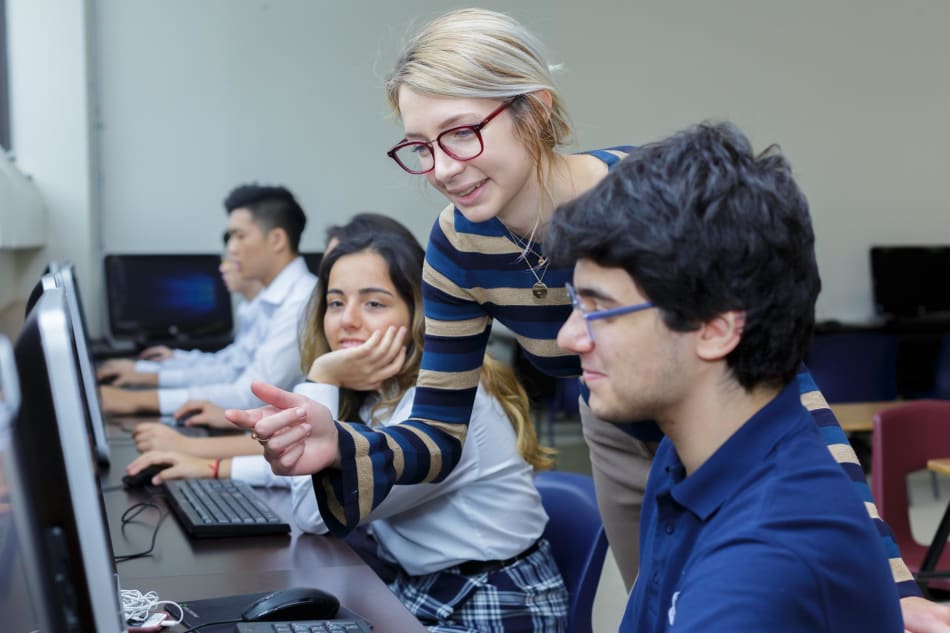Royal Crown School THE OUR KIDS REVIEW
The 50-page review of Royal Crown School, published as a book (in print and online), is part of our series of in-depth accounts of Canada's leading private schools. Insights were garnered by Our Kids editor visiting the school and interviewing students, parents, faculty and administrators.
Our Kids editor speaks about Royal Crown School
Basics & background
Royal Crown School is a coed day and boarding school offering a liberal arts education for students in grades 9 through 12. It was established in 1990, first occupying a location at the intersection of Bayview and Sheppard avenues in downtown Toronto. It’s now at its second location, a property in Scarborough, though it very much remains a Toronto school in feel. It’s close to the amenities of the city, including the cultural institutions for which Toronto is rightly famous. It’s accessible by the largest transportation hubs and customs ports in the country, as well as some of the nation’s signature natural attractions, including Niagara Falls to the south and Algonquin Park to the north. The school is an official IELTS test location for the Centre for English Studies exams.
Royal Crown was founded as an international school, one intending to meet the needs of students arriving in Canada for the purpose of completing their secondary education. In some senses it is within a second generation of international schools in Canada, at least as we typically think of them today. The concept was crafted in the 1970s in response to Canada’s growing desirability as an educational destination. That desirability was based on the strength of the provincial curricula, many of which had undergone significant development, bringing many cutting-edge concepts to bear. In Ontario, the Robarts Plan of the 1960s brought a new focus to student-centred learning and included a distinct curriculum stream designed to prepare students for university. In the early 1970s, provincial minister of education William Davis introduced new divisions within the disciplines—communications, social sciences, pure and applied sciences, and arts—giving students a wider choice of subjects and a greater ability to direct the course of their learning. Also for the first time, students earned credits for specific courses completed rather than simply advancing grade to grade, as had been the case prior. While it may not have been an intention behind the changes, a system of credits meant credit equivalences could also be made. Where students arriving in Canada prior simply entered the same grade as their age mates, they could now pick up their studies where they last left off, gaining credit for courses completed elsewhere for their Ontario high school diploma.
Canada was also seen as a safe destination and a logical stepping stone to North American post-secondary programs. This was particularly of interest to students from Asia, where competition for post-secondary admission was fierce, with students competing for a limited number of seats. As such, Canadian schools provided access to a range of aspirations that, at home, might well be out of reach.
The problem, if there was one, was that international schools tended to be somewhat isolated within the mosaic of Canadian education. While they were being established in the heart of cities across the country, they were largely unseen and tended to keep to themselves. Further, the student populations didn’t include domestic students. These were schools only for international students, and those who attended often completed their degrees without ever getting to know any Canadian peers or being compelled to speak English outside class time.
Royal Crown was designed and developed to address precisely those deficits. The staff and faculty knew intimately what overseas students needed on arrival and throughout their time here, from ESL instruction to counselling around visa and travel requirements to extracurricular programs developed with their interests in mind. That said, they also saw those things as merely the baseline and the school consistently distinguished itself in its ability to improve on the model. Class sizes were kept small. Instruction was student-directed, allowing room to build upon all the perspectives and curiosities students brought with them into the classroom every day. There was also a consistent desire to integrate with the surrounding community and to work more closely with the city’s people and resources. Rather than simply being an island of learners, the school worked to ensure it was a true member of the municipal and academic community at large. That was achieved, in part, through service and volunteerism initiatives, as well as partnerships with key co-curricular programs.
Soon after Royal Crown was founded, enrolment grew to a few hundred students, and that’s where it has remained throughout the school’s life. The first students were almost exclusively from overseas, and today Royal Crown continues to have a large international boarding program, comprising between 70 and 80 percent of the student body. Asia is well-represented, though the nationalities are increasingly balanced and include students from Latin America, Africa, and the Middle East. Over the past few years, the admissions team was augmented to include representatives dedicated to serving each of those regions. In 2021, the school hired its first admissions officer in Vietnam. “We’re looking to better diversify what our student body is,” says principal Steven Saunders. “I think that’s important.” He’s right, it is, and walking through the school on an average day, it’s clear the efforts have paid off.
In many ways, the students at Royal Crown embody what it means to truly be global citizens. For some, Canada is the second or even third stop in their educational journeys. During one visit, we chatted with a student—he was reading in the lobby between classes—who was from Ghana and had arrived at Royal Crown from a school in Montreal. Though just entering the latter part of his high school career, he had already lived on his own for a period of years and had attended classes in three languages. “We have kids who come from China, but their transcripts are from schools in Singapore,” says Lianne Sprigg, head of guidance. Similarly, she recalls a student from Korea who had done most of her elementary and middle schooling in China before coming to Canada for secondary school. “This is something they’re used to,” she says, namely the experience of learning and living with students from around the world. “It’s really nice to watch because you see kids who are so different, who have different ideas, and they just connect.” While they may have different interests, and come from very disparate places, Sprigg feels the experience of living away from their home countries is one of the things that bonds them.
The portion of domestic students at the school is also on the rise. Not long after its founding, Royal Crown turned its gaze to local communities, just as local families, for their part, were discovering the school for themselves. It’s easy to understand why. To enrol here is to enter an authentic global community, one that exists beyond the superficial view of cultural diversity—food, dance, and holidays—and brings peers together in dynamic, meaningful, and often very personal ways. For a Canadian student to learn civics alongside students from Asia and Africa, for example, provides an opportunity for all of them to think about the material in new ways. Further, becoming friends with students who have lived very different lives can be eye-opening, adding a unique and valuable dimension to the high school experience.
Today 25 percent or so of the students are local day students, and the international character of the school is the primary draw. The school’s mandate, informally, at least, is to make the most of exactly that: to grant both domestic and international students the experience of living and learning with people who bring different perspectives and histories into the room. “They want to be exposed to international perspectives,” says Dave Venneri, manager of student recruitment. “This is the best way of doing that without doing an exchange or sending a student overseas.”
Royal Crown moved to its present location in 2019, and the transition marks a new era of its life. The prior site was smaller, and the space was shared. “It never felt like it was ours,” says Spriggs. The current location, she says, absolutely does. While not created for the Royal Crown program, the building has a unique DNA that, in many ways, has worked in the school’s favour. Built in 1977, the campus was created to house Charles O. Bick Police College, the training and education division of the Toronto Police Service. The college operated here until about a decade or so ago, and there are still a few reminders of that time, if you know where to look and what to look for. The nameplates above some of the office doors date from then, and the layout of the classrooms and athletic facilities does as well. No doubt, the fact that the building was designed as a post-secondary teaching environment was one of the things that made it attractive.
The building reflects its age; it doesn’t look like it was built last year, to be sure. There’s a lot of brick and tile inside, and the facade is maybe a bit cold and unremarkable when viewed from the street. Nevertheless, the interior spaces are inviting, spacious, and accessed through a broad entryway. There and throughout the building, the interiors are bathed in natural light. The feel is open and inviting, with lots of clean lines and common spaces. The classrooms range in size from those created for small-group and tutorial instruction to larger and multi-use rooms. At the upper end of the spectrum, there’s a lecture hall with raked seating. “When we took this over, this was their theatre room,” says Saunders during a tour, clearly chuffed a bit to think of all the cadets gathering in this space. “They would show training films here.” That lecture hall has been entirely renovated. The long benches have been replaced with the kind of seating you’d find in a typical university setting.
Indeed, very few of the instructional spaces remain as they were. They have been adapted to bring them up to date and meet the needs of the school. The same is true of the athletic facilities, of which the newly renovated gym is a highlight. The pool was here when the police recruits were, but it has been entirely overhauled and retiled. During a tour when students weren’t on campus, Saunders shows us the locker rooms connected to the pool. They’re excellent, it must be said, though the men’s is considerably larger than the women’s. This is presumably because, in 1977, women weren’t as well-represented in the police force as men. “Yeah,” says Saunders with a chuckle. “We’re going to change that.”
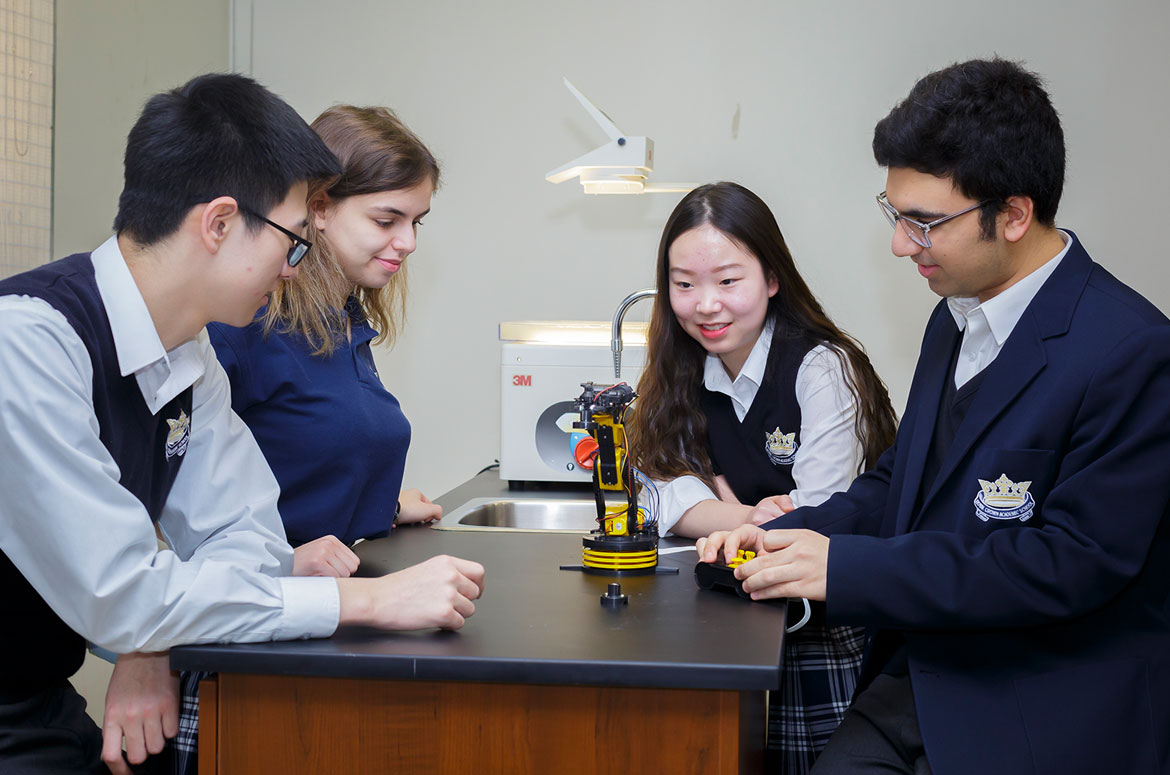
The science laboratories have been updated and are well-appointed with everything you’d expect to find, including cameras required to deliver online and remote learning. During the pandemic, cameras were added to all of the labs and a majority of the other classrooms as well. Where some schools might have looked at cameras as stopgap options when moving online, the equipment at Royal Crown was always intended to remain. The feeling was that, even after the pandemic has become a memory, those tools will continue to be useful, providing remote options for students who need or prefer them. They decided if they were going to do it, they would do it right. And indeed they have.
The windows along the back of the building look out at a substantial area of forested green space. The property abuts Brimley Woods, a civic park that is somewhat miraculous given that it sits within what is now one of the most dense urban areas in the province. In the 19th century the woods were known as Macklin’s Bush, owned by a pioneer family from Ireland. Marshall Macklin was an early environmentalist, and he’s remembered in the Toronto Archives as “the pioneer planter of trees along the roadsides.” The woods became a municipal park when the Macklins sold the property to the city. As a result, much of it feels like untouched forest which, in a sense, it is. Some of the trees are estimated to be 100 to 200 years old. “We can see eagles right out the back,” says teacher Francine Freeman. “We have two eagles that live there. So we have nature in our backyard. … Being so close to the city, that’s hard to find.” Certainly, it is, and it’s a great asset to the school. There are new dormitories going in along the back of the property (more on that below), and once they’re complete, the students who occupy those rooms will have the overlooking view.
• • •
Steve Saunders is the current principal, and when he came to Royal Crown in 2018 he brought a unique constellation of skills and experience. If you were to draft a wish-list CV with all the attributes that would recommend a principal for this school at this point in its life, Saunders’s would match it and then some. After gaining his teaching egree in Canada, he began his career as athletic director at the International Community School in Ethiopia. That led to other appointments, including those in Kuwait and Tunisia, before he returned to Canada in 2000 to support and ultimately lead programs within the public education system. In time, he moved into the private sector, first at Chisholm Academy and then as principal of Columbia International College in Hamilton, Ontario, one of the foremost schools of its kind in North America. In all of that, it’s hard to imagine someone more suited to Royal Crown’s academic and athletic profile.
Saunders is a dynamic leader, and one keen to give instructors and staff the freedom to follow their instincts. He’s very easy to speak with and very willing to listen. One of the strengths of his leadership is the desire, simply, to do things better, and everything—from the cafeteria to the service programs—is seemingly open for consideration. When we visited, he pointed out a room that was being renovated to become a recording studio. Once complete, it will be the focal point of a recording arts program run in collaboration with the Remix Project, a Toronto-based organization working to build connections between young people and the music industry. It’s a unique partnership for the school—it’s frankly a unique partnership for any school—and when Saunders talks about it, his voice rises a bit. He’s right to be excited. The curriculum will include skill development around sound production, music production and performance, and podcasting. The association with Remix will also provide an interface with the music industry within the city. Saunders admits that not all or perhaps none of the students who participate will go on to careers in the music industry, though he’s also clear that that’s not the point. Instead, the value, as with the elite basketball program and the service initiatives, lies in the chances it creates for students to meet new people and access new areas of interest.
While there are no formal relationships with the schools adjacent to Royal Crown—the immediate neighbour to the east is Francis Libermann Catholic High School, and around the corner is Albert Campbell Collegiate Institute—when Saunders points them out during a walk around the school property, it’s clear the gears are turning. At the moment, the Francis Libermann swim team uses the Royal Crown pool to train. Reciprocally, Royal Crown uses their outdoor fields for recreation and athletic practice. It’s a good relationship, and clearly the start of one that, as it grows, will bring an expanded sense of community for students and instructors.
Looking to the future, Saunders notes growth is a goal, and there is a significant capital project underway to develop the school site. The project will nearly double the space and bring, for the first time, the boarding program onto the campus proper. It will include a dormitory, to be christened Northwood Hall, with both single and double rooms. Also included in the addition are recreational spaces, student lounges, 11 study halls, and a significant extension of the food service facilities. The design is an adaptation of a building the same architectural firm created for York University. When asked what he hopes the project will realize, Saunders answers that he’s most excited about how it will unite all aspects of the student experience: recreation, instruction, co-curricular activities, and residency. Once complete, the property will be a campus in the fullest sense of the term, with Royal Crown becoming the only international private school in the city to have a student residence on its grounds.
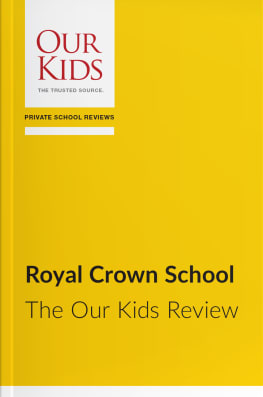
Key words for Royal Crown School: Diversity. Creativity. Support.
Academics
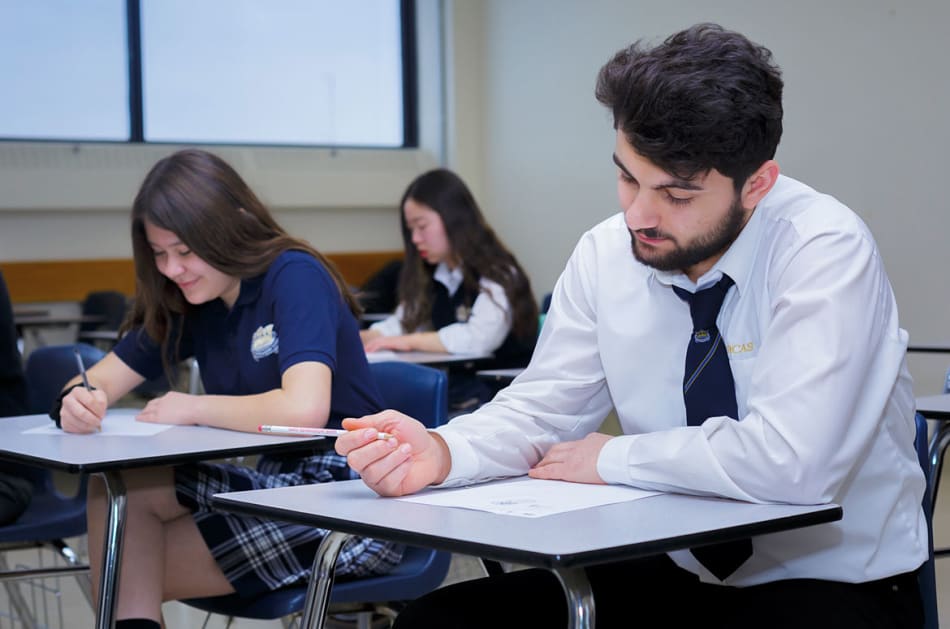
Royal Crown is a preparatory school in the classic sense. All the programs and scheduling have been crafted to grant students the requirements, skills, and postures they’ll need to gain entry to the university of their choice and to thrive while there. The average class size is between 10 and 15 students. There is a focus on core academics, as well as research, independent thinking, data analysis, report composition, and public speaking. Students graduate having covered the curriculum as well as having engaged in individual and group work; they’ve communicated ideas with peers and had a hand in developing and delivering projects; they’ve had opportunities to experience a range of leadership roles and to help in providing service programs within the wider community.
Teachers are thoughtful and bright, and hiring favours instructors who have something more to give than simply a tour through the curriculum. Going off topic in pursuit of fruitful and fascinating digressions is normal. Some, like physics instructor Reza Ghahnavyeh, have advanced degrees (he has a PhD) and have taught at the university level (he taught at the University of Toronto). The teachers we met brought spark and personality to the classroom, which was especially true in Ghahnavyeh’s case. When we asked why he feels physics is important, he breaks out in a huge grin, saying, “Everything we understand is physics. Even literature is physics! Law is physics; business is physics.” If you’re looking for a person who can bring joy to the discipline, Ghahnavyeh would be at the top of the list. “Complex systems,” he continues, “thinking, dreaming, imagination—all are physics!” He makes a convincing case that economics follows the laws of thermodynamics. It’s truly hard not to be buoyed by that kind of enthusiasm.
“Being a teacher isn’t just about being prepared,” says Harmony Perez, head of the English department. “It’s also about adapting.” She says she feels it’s important to be open to new opportunities as they arise, and she and others at the school are demonstrably prone to do exactly that. In 2019 there was a climate strike in Toronto, and students from schools across the city were gathering to take part. It was an international initiative—rallies were held that day in cities across North America and around the world—to raise awareness of the ways in which governments can address climate change. For the world, it was a moment. For art teacher Francine Freeman, it was an opportunity for students to learn something about what it means to raise their voices in participation with others and to experience the ways in which art can play a role in a wider cultural discussion. Freeman had students screen-print T-shirts and make posters, and then use them when participating in the march. Amid a peaceful crowd on a cool fall day, they wove a path through downtown Toronto, ultimately arriving at Queen’s Park, the site of the Ontario provincial legislature. They gathered with peers and listened to speakers. Some of the Royal Crown students were interviewed by local media.
It’s something they’ll never forget, and for some, it may well be that galvanizing moment they’ll look back on years from now, thinking of it as the first time they added their voices to a larger conversation. For Freeman, this is what art is ultimately all about: making things in order to engage in productive discussion with others around some important ideas in our lives. “If they can create a good piece of artwork,” she says, “it doesn’t mean anything unless they know how to market it, to take it out in the world [to use it] to fight for something they believe in [and] to get passionate about something.”
Not all lessons are as grand as that, but the desire to extend the curriculum is common throughout the school. When I ask Perez which text she most enjoys teaching, she answers Shakespeare’s Hamlet. That’s somewhat surprising, given that many of her students are learning in their second or third language. (And it’s Shakespeare, which is something of a language unto itself.) She says the reason she likes to teach it is because of the relatability of aspects of Hamlet’s experience. “He’s not just a prince,” she says. “He’s also a young guy trying to figure himself out. He’s told what to do, but he’s trying to figure out what his place is in the world. … He’s trying to do the best he can, even though it doesn’t always translate into the wisest decisions.” Her students, on a lesser (and less hazardous) level, are also trying to figure themselves out. “He stays true to himself, and he does what he can in a world full of all of these pressures and expectations.” Her students, of course, are as well. Perez is fully aware that they might not understand all the literary nuance, but they are nevertheless able, with the right introduction, to access the emotions of the work. “If they are able to see him as someone who could be potentially like them,” she says, “it helps in their understanding of the play.” Which is absolutely true.
When we asked Perez what she likes most about her work, she answers, “I like hearing the kids’ thoughts on things.” It’s a sentiment that’s shared throughout the faculty, and it’s a core element of the success of the program. Interpersonal interaction is prized, and there’s good use made of group work and situations in which students are required to collaborate, discuss ideas, and share thoughts. Those things are helpful now—they make for a better learning experience—but will also be essential when the students move on. Freeman says, “We make the effort to really engage the class because we know they’re going to be placed in situations where they’re going to have to speak and they’re going to have to interact with other people” in their post-secondary and professional lives.
• • •
Royal Crown is accredited by the Ontario Ministry of Education and delivers the Ontario high school curriculum, ultimately conferring the Ontario Secondary School Diploma (OSSD). It’s ranked in the top 15 percent of high school diplomas among developing countries (PISA, OECD, 2014) and is recognized internationally as an admission standard on par with the International Baccalaureate and Advanced Placement diplomas. “It’s easy to be critical of government or education,” says Venneri in a nod to Canadians’ proclivity to being overly humble. “But at the end of the day, the OSSD ranks very high. So if you graduate with it, you can apply to universities in Australia, you can apply to universities in Germany, the US … you can apply to universities around the world.” Not all degrees are as transferrable, and Venneri says it’s a primary draw for the students who enrol here.
In order to complete the OSSD, students are required to complete at least 30 credits in grades 9 through 12. Some of the credits are mandatory, and they represent the core curriculum: English, math, science, history, geography, arts, health and physical education, French, career studies, and civics. The remaining credits are subject to students’ discretion and chosen from a list of recognized courses. These include technology and computer studies, graphic and performing arts, world studies, international languages, social studies, and co-operative education. The discretionary credits allow students to design a course of study that reflects their interests and prepare for their post-secondary career. In addition to coursework, students are required to complete 40 hours of volunteer community service and pass the Ontario Secondary School Literacy Test. It is a standardized test, written every year in March or April, that’s intended as an objective assessment of students’ reading and writing skills.
Royal Crown also offers a university preparation year meant for students who already have a secondary school diploma but would like to augment their transcript. They are able to gain credit equivalencies from their previous studies, taking any additional credits needed to fulfill the OSSD requirements. For the vast majority, it’s time very well-spent. One of the things students experience, almost without exception, is a 10 percent drop in marks between their last year in high school and their first year in university. Venneri says the program was created to address exactly that. Historically, for the students who complete the university-prep year, the drop is significantly less or, in many cases, not there at all.
For some students, it’s a chance to match the skills, knowledge, and academic experience of the peers they’ll join when they enter university. “For countries that follow the UK model, as in many African countries, they’re young when they graduate,” says Venneri. “They graduate at 15. So they come for a year to mature.” There are also differences within the curriculum, particularly in math and science. “Although they have the credit, their academic skills aren’t close to what they’ll need for first-year university. So they use this as a practice year. They make mistakes; they figure out the North American system.” Venneri adds that, for many, “they’re also learning how to be away from home, the skills of life, and how the North American education system works.” And they’re doing that before they get to university, a setting that can be less forgiving. “Here you can make mistakes in the first semester, in the first week. You can fail tests,” he says, and really not jeopardize any longer-term success. Says Venneri, “The program is designed to allow you to figure it out in the beginning. Then, once you hit your stride, the marks improve.”
Athletics
Sports feature highly in the school, with a majority of students taking part in some form of physical activity, ranging from recreational swimming to elite, world-class competitive basketball. Activity isn’t mandatory, though the student population is, nevertheless, an active one. Basketball is the headline. In every way, it is the first thing most people see of the athletic program and, increasingly, the first thing they encounter at the school. Though still relatively new—it was launched in 2019—the basketball program has added dimension to student life while gaining public notice for the school. It’s also trained some phenomenal players and turned lots of heads in the sporting world. Students from both sides benefit from it, those who are in the program and those who aren’t.
By its second year, the basketball program attracted nearly 30 students, which is substantial. They arrived from the local community, as well as Western Canada, Montreal, and throughout Ontario. It also attracted corporate sponsorship, and today Royal Crown is the only high school in Canada to host a Nike Basketball program.
Co-curricular programs
The co-curricular programs extend the academics often in delightfully creative ways. There are the typical clubs and organizations you’d expect to find, as well as special events through the year. They include trips to see the sights—Niagara Falls is understandably high on many students’ lists—and in-house pop-up events, like cooking workshops led by the head of food services.
Service learning is offered through some signature projects which, additionally, help students fulfill the 40 hours of community involvement required to complete the OSSD. A key project is the Blue Monday Donation Bus, for which students gather and distribute used clothing and hot food to members of the city’s homeless population. Stops typically also include a youth shelter, seniors residences, and Muslim Welfare Canada. “It’s really wonderful,” says Freeman when speaking of the students’ interaction with those they meet along the way. Prior to going to a seniors centre last year, she says, “we put everything in bags, and [the students] said, ‘How about we write some nice, positive messages.’” So they did. She pauses, maybe getting a bit lost in the thought. “It was really wonderful.” In another annual project, at the end of each school year, art students take supplies into seniors residences to mount art therapy sessions over the course of three days. Seniors are partnered with students to complete the projects.
“The students need to know how to take care of their community and their planet,” says Harmony Perez. “Giving them the opportunity to do this sets them up for skills that go beyond the school. And it’s really important to motivate them to do things like that.”
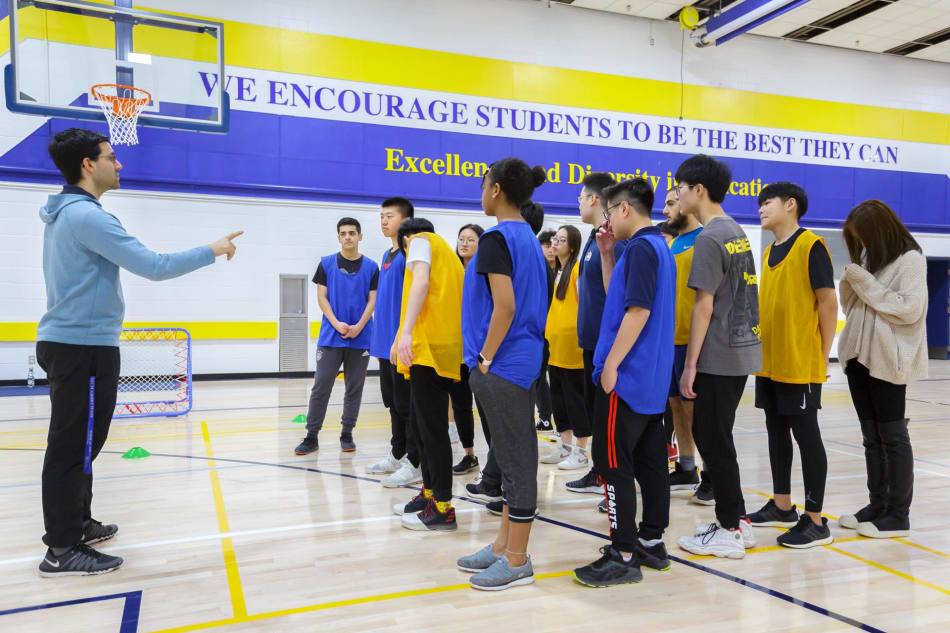
Student population
On the second floor of the school, there are photos of students—not just a few, but dozens—who have won regional and national math competitions. (If the world of competitive math were compared to the Olympics, some of these students would be gold medallists.) Similarly, in the gym, there are world-class basketball players—again, not just one, but many—who have been scouted by athletics programs. On any given day, there are also students creating public art, teaching seniors how to knit, and learning to swim; others are finding their voices, discovering a passion, and working with others around shared projects and initiatives.
There is so much diversity in the ranks—you’re as likely to meet a basketball prodigy as you are a competitive mathematician—it can be hard to know what the students share. One, though, is an overt orientation toward academic achievement. “For many of these students, getting anything under 85 percent is like the world is ending,” says Lianne Spriggs. “It’s a challenge for us to balance the academics with the social.” But they do, and the students respond well to it. These are kids who appreciate the opportunities they’ve been given, and they are prone to run with them. While not all students arrive with a specific post-secondary program in mind, many do. All are well ahead of the curve in that they know they want to attend university, have a developed sense of their personal aptitudes and academic goals, and have at least a general sense of what they’d like to study after high school. In part, that’s a function of the work and dedication required for students to go so far away from home in order to study. Once here, they’re well-primed to make the most of it.
The reasons they come to Canada are many. For some, it’s simply the chance to live overseas and become fluent in English. For others, the reasons are more prosaic, including safety, or to access a broader, more international curriculum. For all of them, there is an intention to gain a world-class education and to acclimate to life in North America in preparation for university. “They’re looking for that freedom and that ability to express themselves,” says Perez. “I’ve also had kids who just really like travelling, and they feel Canada is a good jumping-off point” into an international experience and an international lifestyle. Since the creation of the elite basketball program, there are also more students arriving from the US than at any point in the school’s life.
At the moment, most students board in a student residence near the main campus that’s accessible by shuttle, while others make use of the homestay program, which is managed through a third party. The residence, once a hotel, has all the amenities and safeguards parents of international students would rightly expect: meals, recreational facilities, shared spaces, and round-the-clock supervision. Uniquely, the residence is open 365 days a year, as is the food service program. That’s atypical for boarding programs; while there are some instances where schools will offer the option to board over holidays at an extra fee, here there is no fee required. It’s true that most students don’t stay over the winter break, but given the demands of international travel, many families appreciate that they have the option. Once the new addition is complete, set for July 2022, boarding will move to the campus proper.
Daily life is close-knit, due in part to the goals the students share, as well as the size of the school. Royal Crown is big enough to have all the curricular, co-curricular, and administrative bells and whistles, while small enough to feel like home. Perez says the students are looking for “a home-away-from-home kind of feel,” and she’s pleased to note that’s exactly what they find. There’s a broad, cross-generational cast to the school community. “I like how the kids have the opportunity to connect with their teachers and the other staff of the school at a deeper level,” she says. “I like how the students tend to rely on the teachers more, because they’re looking for that anchor. I like that we’re able to give that to them. For me, it gives a sense of purpose.”
The departments that make up student services (admissions, student life, guidance) are prominent and accessible in the school. In fact, they’re literally the first thing you see when you enter the administrative suite just off the lobby. All departments are well-staffed and address everything from academic and personal counselling to arranging airport pickups and bus trips to advising on immigration requirements.
Counselling is well-organized, and most students visit frequently to discuss academic progress beginning when they arrive on campus. There, students meet one-on-one with recruiters from universities throughout the province and across the country. The school hosts an annual university fair each October, as well as university application seminars throughout the fall.
Food service is handled entirely in-house, overseen by chef William Shi. Shi brings 30 years’ experience in hospitality, including positions at Sheraton Hotels in Canada and abroad. He’s also directed food services at McMaster University and the University of Waterloo. He was brought on at Royal Crown to develop a comprehensive offering unique to the school that is responsive to a culturally diverse student body. Saunders delightfully refers to him as “Chef,” as in, “Chef does demonstrations for students.” Which, indeed, he does; the school has a teaching kitchen he uses for just that purpose. In addition to having a wide array of experience, Shi is also jovial, absolutely approachable, and keen to address students’ tastes while also gently expanding them. For him, food service is about more than what you eat. The dining hall is a centre of student social life, as it should be, something he’s looking forward to developing further with the expanded property.
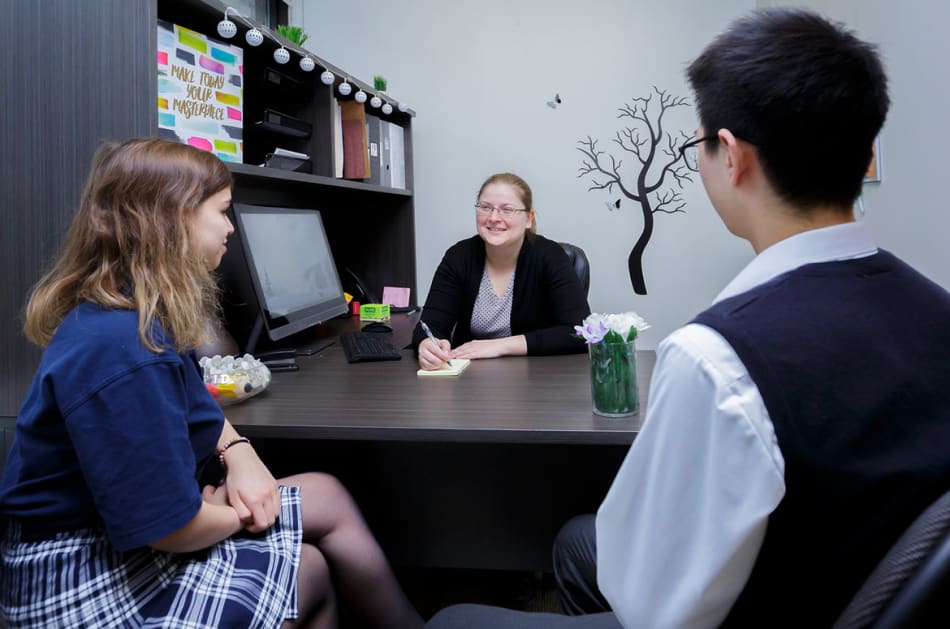
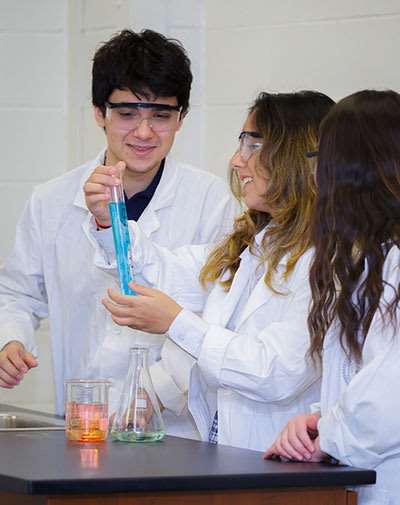
Getting in
Royal Crown offers a number of entry points throughout the calendar year, limited not to just the fall and winter semesters, and effectively at any month of the year. It also offers the opportunity for students to enter at any grade. Those arriving near the end of their secondary career, and specifically intending to augment their education in order to enhance their university application, can choose to complete all their admission requirements within a 10-month period. So there’s a lot of flexibility and an expressed willingness to work with students one-on-one to make sure they’re arriving when they should and getting the most of their time at Royal Crown relative to their academic and personal goals.
The application process is typical, for the most part, with all the expected elements: the completion of a detailed application form and the provision of transcripts and an application fee. Students are also required to take two placement tests, one in English and one in math. Students for whom English is not their first language all sit an ESL placement test and will be levelled/placed within the ESL program based on their result.
Students arriving in Canada to attend Royal Crown will need travel documents, though the requirements vary depending on the country of origin. Many will require a visa, though not all. A student permit is necessary for stays longer than six months.
The takeaway
The academic program at Royal Crown is strong, though part of its strength comes from being more student-directed than is possible in larger institutions. Likewise, there are partnerships with local schools and organizations, and opportunities for students to engage meaningfully with them. The recent addition of an elite basketball program advances the theme, bringing new areas of interest and new student communities into the Royal Crown fold.
One of the things that continues to distinguish Royal Crown in the educational market is that success isn’t only defined in terms of university admittances and marks earned. Rather than being purely transactional, the faculty work to make the student experience more relational. Yes, students gain what they need to get into the university of their choice, but they get much more besides. When asked what she’d like students to recall after they’ve moved on, teacher Harmony Perez says, “I want them to remember that, well, Ms. P really taught me a lot of life lessons. That she didn’t just teach me English—she taught me how to be a person of integrity and a person who knows how to speak their mind and is not afraid of making mistakes. Who is willing to grow. I think that’s what I want them to take away from my class.”
That’s key to the offering. There’s an awareness that success can mean many different things to different people, but that for everyone, success is personal and about reaching personal goals, not institutional ones. “It’s important to have academics, and our academics are really high,” says Perez. “But everything else is a part of their high school experience.” She’s right, of course. It is. And it’s that difference that she and her colleagues intend to impart to the students whose lives they touch, no matter whether they arrive from down the street or the other side of the world.
